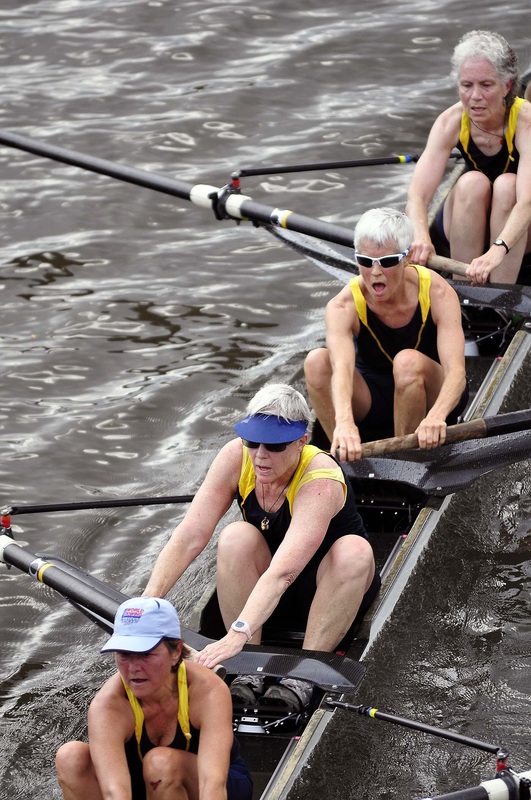Hanne Caraher loves rowing. She’s very good at it. So good, she’s won a national gold medal and has competed in championships in Canada, Poland, Germany and Hungary (she won there too). After years of early morning practices—which meant arising at 4:20 a.m. five days a week—she’s now rowing with the Gray Knights at Thompson Boat Center in Washington, DC.
She’s only been rowing for 11 years now. And she started when she was 72.
“I found all the things that were connected with rowing were fun. It totally changed my life,” said Caraher, now 83, who also won a medal in 2019 on a boat rowed by competitors whose average age was 80.
Caraher is not alone in her love of the sport. More and more older adults are discovering rowing as a way to stay physically active, as well as mentally and socially engaged. USRowing, the sport’s governing body, says its membership grew from about 67,000 in 2013 to 75,000 in 2018 (the most recent tally available). About 14 percent of members are 50 and older. (While there’s no gender breakdown for older rowers, women make up about 53 percent of USRowing’s total membership.)
At the 54th Head of the Charles Regatta—one of the sport’s biggest events, held on the Charles River in Massachusetts—about a quarter of entries in 2018 were men and women 50 and up.
Even as COVID-19 curtailed many races and team activities, older rowers still stay in shape through indoor rowing, virtual races, singles boats (allowing rowers to remain safely distanced) or other safety measures. And while some competitions are on hold, that doesn’t dampen the enthusiasm that older rowers express for the sport.
“Rowing has got under my skin like no other form of exercise ever has,” said Patricia Carswell, a British rower in her 50s, who blogs and podcasts about rowing at GirlontheRiver.com. “The river has me in its thrall, and I love the endless challenges that go with such a technically difficult sport.”
Vigorous but Safe
Rowing offers all the benefits of vigorous exercise, but with minimal risk of injury or impact on the joints—a plus for older adults. Contrary to popular belief, rowing is not just an upper-body exercise. It uses all the body’s major muscle groups: legs, arms and core (torso).
“Rowing puts only minimal stress on the joints, far less than walking, running or biking,” said Mark Slabaugh, MD, an orthopedic sports-medicine surgeon with Orthopedics and Joint Replacement at Mercy Medical Center in Baltimore. “Only swimming is less strenuous on the joints. Those with limited range of motion in any of their joints can still participate in rowing, due to the low stress on the hips, knees, ankles and shoulders.”
Slabaugh said he might caution patients with symptomatic, rotator-cuff tears (a type of shoulder injury) against rowing. Otherwise, the sport is safe for most people, he said, adding that newbies of any age should start slowly, building up intensity gradually.
Research confirms the fitness benefits. Slabaugh cited a 2012 study in Japan that measured the results of an indoor rowing regimen for a group of older men: improved aerobic capacity, decreased fat and improved muscle tone, all key metrics for functional health for older people. Researchers have also found that the lungs of rowers who train seriously use oxygen more efficiently than those of most other athletes.
The focus on the present moment and mindfulness in rowing is a kind of Zen.
— Charles Gilbert
In addition, studies have found that rowing improved physical fitness among breast-cancer survivors. They were once urged to avoid lifting or exerting their shoulders, to reduce the risk of lymphedema; now, many doctors encourage them to row. Rowing groups have sprung up specifically for breast-cancer survivors.
Like other forms of vigorous exercise, rowing may ward off depression. Some rowers say that the rhythmic, repetitive nature of rowing is like meditation.
“The focus on the present moment and mindfulness in rowing is a kind of Zen,” said Charles Gilbert, 66, who rows with Princeton National Rowing Club in Princeton, NJ. “A Zen practitioner told me that my rowing 1.5 hours a day on the water constituted my Zen practice.”
Rowing also benefits the brain. It involves learning new skills that require concentration, which may offer added brain health benefits. Most boat clubs offer “learn to row” programs, generally about six weeks long, to teach newbies the basics, but rowers never stop improving their technique.
“Rowing is a lifetime sport,” said Tom Murphy, 67, president of Rocky Mountain Rowing Club in Denver. “It appears easy to learn the basic motion, but it takes a lifetime to master.”
Competition as Motivation
While older adults can row recreationally, many compete as part of a team in races and regattas, and that can push them to train harder and more consistently.
“When you’re in a boat with other people, you can’t stop,” said Lisa Miller, 56, who rows with Dallas United Crew in Dallas, TX. “It pushes you to get past your limits. On my own, in the gym, I would’ve stopped.”
Miller likes the sense of accountability. For example, she said, if one person doesn’t come to practice, the coach must rearrange seating on the boats. “You don’t want to mess up your teammates,” she said. “You don’t want to get that call from the coach, asking, ‘Where are you?’”
Rowing is one sport where team members look forward to getting a year older.
For some, rowing is their first experience of athletic competition.
“I’m a pre-Title IX babe,” said Joanne Caye, 72, a rower in North Carolina. “I didn’t get this stuff when I was in school. Just to be able to compete is something that is really heady for me. I get pushed in absolutely wonderful ways. I never knew that about me.”
Caye was introduced to the sport in her late 40s through another mom on her son’s high school rowing team. Now, 25 years later, her son is grown (and no longer rowing) and Joanne is retired, but she’s still rowing as part of Carolina Masters Crew Club.
Rowing allows people to remain competitive even as they age. Classification is based on age, and handicaps are assigned based on these classifications, allowing young and old to compete fairly, side by side. Gilbert jokes that rowing is one sport where participants look forward to getting a year older, because that helps boost the boat’s average age, raising the handicap.
“In rowing, the goal is to get older and stronger, so that you can keep contributing,” he said.
‘Built-in Sisterhood’
Rowing teams often form close-knit communities that stay connected outside of practice and during the off-season. Many clubs host social gatherings, philanthropic service projects and classes for disadvantaged children or disabled veterans. For retired older adults, regular rowing practice creates routines and teamwork that many miss after leaving the professional world.
As a retired professor of social work, Caye sees a lot of value in the intergenerational social connections she’s made as a rower. “It’s wonderful to have a built-in sisterhood,” Caye said. “Rowing connects me with women who are younger than me and keeps me attuned to changes in trends.”
Liz Jenista, 37, is one of those younger women on Caye’s team. She’s been rowing with the same club for 15 years. Having moved from California to North Carolina soon after graduating from college, Jenista calls her rowing club her “multigenerational family away from my actual family.” Friends made through rowing have become an important support network, helping her and her husband navigate the job market, purchase a house and even parent their two children, ages six and 10. Some rowers handed down gently used clothing and supplies when her children were babies; others have babysat. When they rode together for hours on the way to regattas, Jenista often asked teammates for advice on child rearing.
“Talking through behavioral challenges and hearing about [older members’ children] who faced similar challenges but grew up and became successful adults—that’s so reassuring,” Jenista said. “It’s been very valuable having the perspective of older women.”
Time in Nature
Most competitive rowers spend time on indoor rowing machines, whether in the off-season, during inclement weather or due to COVID-19 restrictions. But the time spent outdoors is a key attraction—and a major benefit—of rowing.
“The benefits are even more profound when you’re in nature, breathing clean, fresh air and getting away from the normal daily routine, especially during COVID when we need to avoid staying indoors for too long,” said sports-medicine surgeon Slabaugh.
There’s a growing body of research that suggests time spent outdoors itself has benefits. In a 2019 study published in Scientific Reports, a journal published by Nature, 20,000 study participants reported better health and well-being when they spent 120 minutes or more in nature each week.
Many rowers commented on the magical feeling of rowing on a body of water early in the morning before the world is awake.
“You’re getting back to nature,” said Miller, the Dallas rower. “You’re out on the water and it’s quiet, except for the clicks of the oars. You see these beautiful sunrises. It’s a great way to start the day.”

Freelance writer Mary Jacobs lives in Plano, TX, and covers health and fitness, spirituality, and issues relating to older adults. She writes for the Dallas Morning News, the Senior Voice, Religion News Service and other publications; her work has been honored by the Religion Communicators Council, the Associated Church Press and the American Association of Orthopaedic Surgeons. Visit www.MaryJacobs.com for more.



